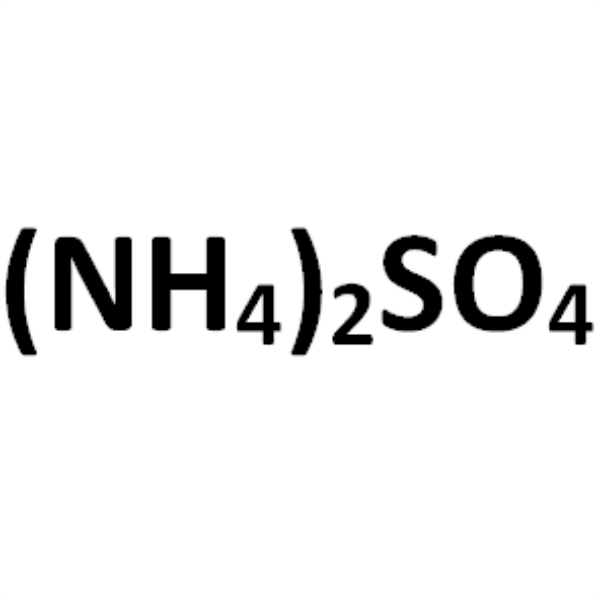Ammonium Sulfate CAS 7783-20-2 Content 99.0~100.5%
Shanghai Ruifu Chemical Co., Ltd. is the leading manufacturer of Ammonium Sulfate (CAS: 7783-20-2) with high quality. Ruifu Chemical can provide worldwide delivery, competitive price, excellent service, small and bulk quantities available. Purchase Ammonium Sulfate, Please contact: alvin@ruifuchem.com
| Chemical Name | Ammonium Sulfate |
| Synonyms | Ammonium Sulphate; (NH4)2 SO4 |
| Stock Status | In Stock, Commercial Scale |
| CAS Number | 7783-20-2 |
| Molecular Formula | H8N2O4S |
| Molecular Weight | 132.14 g/mol |
| Melting Point | >280℃(dec.) |
| Density | 1.77 g/mL at 25℃(lit.) |
| Refractive Index n20/D | 1.396 |
| Odor | Slight Odor of Ammonia |
| Sensitive | Easily Absorbing Moisture |
| COA & MSDS | Available |
| Brand | Ruifu Chemical |
| Items | Inspection Standards | Results |
| Appearance | White to Off-White Crystalline Powder | Complies |
| (NH4)2SO4 Content | 99.0%~100.5% | Complies |
| Water by Karl Fischer | ≤0.20% | <0.20% |
| Residue on Ignition | ≤0.005% | <0.005% |
| Insoluble Matter in Water | ≤0.005% | <0.005% |
| Limit of Phosphate (PO₄) | ≤5ppm | <5ppm |
| Chloride (Cl) | ≤5ppm | <5ppm |
| Nitrate (NO₃) | ≤10ppm | <10ppm |
| Iron (Fe) | ≤5ppm | <5ppm |
| Arsenic (as As) | ≤2ppm | <2ppm |
| Calcium (Ca) | ≤5ppm | <5ppm |
| Heavy Metals (as Pb) | ≤10ppm | <10ppm |
| pH | 5.0~6.0 | Complies |
| Solubility (In Water) | Clear Colorless(2 g in 3 ml) | Complies |
| X-Ray Diffraction | Conforms to Structure | Complies |
| Conclusion | The product has been tested & complies with the specifications | |
Stability: Stable. Contact with strong oxidizers may cause fire or explosion. Incompatible with strong bases.
Package: It is packed with polyethylene bag as inner layer, and a compound plastic woven bag as outer layer. The net weight of each bag is 25kg. Or according to customer's requirement.
Storage Condition: Store in a cool, dry and well-ventilated warehouse away from incompatible substances. Kept away from heat and moisture during transportation, unloaded with care so as to avoid damage. Furthermore, it must be stored separately from poisonous substances.
Shipping: Deliver to worldwide by air, by sea, by FedEx / DHL Express. Provide fast and reliable delivery.
How to Purchase? Please contact Dr. Alvin Huang: sales@ruifuchem.com or alvin@ruifuchem.com
15 Years Experience? We have more than 15 years of experience in the manufacture and export of a wide range of high quality pharmaceutical intermediates or fine chemicals.
Main Markets? Sell to domestic market, North America, Europe, India, Korea, Japanese, Australia, etc.
Advantages? Superior quality, affordable price, professional services and technical support, fast delivery.
Quality Assurance? Strict quality control system. Professional equipment for analysis include NMR, LC-MS, GC, HPLC, ICP-MS, UV, IR, OR, K.F, ROI, LOD, MP, Clarity, Solubility, Microbial limit test, etc.
Samples? Most products provide free samples for quality evaluation, shipping cost should be paid by customers.
Factory Audit? Factory audit welcome. Please make an appointment in advance.
MOQ? No MOQ. Small order is acceptable.
Delivery Time? If within stock, three days delivery guaranteed.
Transportation? By Express (FedEx, DHL), by Air, by Sea.
Documents? After sales service: COA, MOA, ROS, MSDS, etc. can be provided.
Custom Synthesis? Can provide custom synthesis services to best fit your research needs.
Payment Terms? Proforma invoice will be sent first after confirmation of order, enclosed our bank information. Payment by T/T (Telex Transfer), PayPal, Western Union, etc.
Risk Codes
R10 - Flammable
R36/37/38 - Irritating to eyes, respiratory system and skin.
R22 - Harmful if swallowed
Safety Description
S37/39 - Wear suitable gloves and eye/face protection
S26 - In case of contact with eyes, rinse immediately with plenty of water and seek medical advice.
S36 - Wear suitable protective clothing.
S24/25 - Avoid contact with skin and eyes.
WGK Germany 1
RTECS BS4500000
TSCA Yes
HS Code 3102210000
Toxicity LD50 orally in Rabbit: 2840 mg/kg
Ammonium Sulfate (CAS: 7783-20-2) is an inorganic salt used as a food additive, in fertilizers, water treatment and fermentation.
1. An excellent nitrogen fertilizer (commonly known as fertilizer field powder), suitable for soil and crops, can make branches and leaves grow vigorously, improve fruit quality and yield, and enhance the resistance of crops to disasters. It can be used as base fertilizer, top dressing and seed fertilizer.
Ammonium Sulfate is a kind of nitrogen fertilizer which can provide N for NPK and mostly used for agriculture. Besides providing the element of nitrogen, it can also provide the element of sulphate for crops, pastures and other plants. Because of its fast release and quick acting, ammonium sulfate is much better than other nitrogen furtillizers such as urea, ammonium bicarbonate, ammonium chloride and ammonium nitrat.
Mainly used for making compound fertilizer, potassium sulfate, ammonium chloride, ammonium sulfate, etc
Ammonium Sulfate is the earliest production and use of nitrogen fertilizer. It is usually used as a standard nitrogen fertilizer, nitrogen content is between 20% to 30%. It is a very important fertilizer for any kind of soil that's high in pH and needs a little bit of sulfates to work against the high calcium or the high pH. The nice thing about the Ammonium Sulfate is that the nitrogen in it is a little bit slower releasing so it lasts throughout the growing season better than the nitrate forms of nitrogen.
Ammonium Sulfate serves as physiological acidic nitrogen fertilizer, is generally more suitable for wheat, corn, rice, cotton, potato, hemp, fruit trees, vegetables and other crops. For soils, the Ammonium Sulfate is most suitable for neutral soil and alkaline soil, but not suitable for acidic soil. Also used as analytical reagents (precipitating agent, masking agent), in electrochemical analysis, supports electrolyte, microbiological culture media and preparation of ammonium salts.
2. can also be used for rare earths mining, mining uses Ammonium Sulfate as raw material, and uses ion exchange to exchange rare earth elements in the ore.
3. Ammonium Sulfate is an inorganic sulfate salt used for molecular biology. It is mostly used in protein purification process. With excellent solubility, ammonium sulfate can form a high salt environment to make a preparing for the protein precipitation and subsequent high salt purification. Ammonium sulfate has been used in the preparation of ′Blue Silver′ colloidal Coomassie stain for proteins. Ammonium sulfate may be used for the precipitation or fractionation of proteins or for purification of antibodies. It is also useful for crystallographic analysis of nucleic acids and proteins.
4. Used as flux, fire retardant in textile fabric industry, as the salting-out agent, osmotic pressure regulating agents in medicine.
5. Used as raw materials of hydrogen peroxide , ammonium chloride, ammonium alum and production in chemical industry, as a flux in the welding industry.
6. Used as dough modifier, yeast nutrients in food grade product.
Moderately toxic by several routes. Human systemic effects by ingestion: hypermotility, diarrhea, nausea or vomiting. See also SULFATES. Incandescent reaction on heating with potassium chlorate. Reaction with sodmm hypochlorite gves the unstable explosive nitrogen trichloride. Incompatible with (K + NH4NO3), KNO2, (NaK + NH4NO3). When heated to decomposition it emits very toxic fumes of NOx, NH3, and SOx.
(NH4)2SO4 132.14
Ammonium Sulfate [7783-20-2].
DEFINITION
Ammonium Sulfate contains NLT 99.0% and NMT 100.5% of (NH4)2SO4.
IDENTIFICATION
• A. Identification Tests-General, Ammonium <191>: A solution (1 in 20) meets the requirements.
• B. Identification Tests-General, Sulfate <191>: A solution (1 in 20) meets the requirements.
ASSAY
• Procedure
Sample: 2.5 g of Ammonium Sulfate
Titrimetric system
(See Titrimetry <541>.)
Mode: Residual titration
Titrant: 1 N sodium hydroxide VS
Back titrant: 1 N sulfuric acid VS
Endpoint detection: Colorimetric
Blank: 50.0 mL of 1 N sodium hydroxide VS, accurately measured
Analysis: Add the Sample to a 500-mL conical flask and dissolve in 50 mL of water. Add 50.0 mL of 1 N sodium hydroxide VS, place a filter funnel loosely in the neck of the flask, and boil until ammonia is expelled (about 10-15 min), as determined with litmus paper. Cool, add 0.15 mL of thymol blue TS, and titrate the excess sodium hydroxide with 1 N sulfuric acid VS. Perform a blank determination.
Calculate the percentage of ammonium sulfate [(NH4)2SO4] in the Sample taken:
Result = [(B V) × N × F ×100]/W
B = 1 N sulfuric acid VS consumed by the Blank (mL)
V = 1 N sulfuric acid VS consumed by the Sample (mL)
N = actual normality of the Back titrant (mEq/mL)
F = equivalency factor, 66.07 mg/mEq
W = weight of the Sample (mg)
Acceptance criteria: 99.0%-100.5%
IMPURITIES
• Residue on Ignition <281>
Sample: 20 g
Acceptance criteria: NMT 0.005%
• Limit of Insoluble Matter
Sample: 20 g
Analysis: Transfer the Sample to a covered beaker, and dissolve in 200 mL of water. Heat to boiling, and warm on a steam bath for 1 h. Filter the hot solution through a tared sintered-glass crucible of medium porosity (10-15 µm). Wash the beaker and the filter with hot water, dry the crucible at 105, cool in a desiccator, and weigh.
Acceptance criteria: NMT 1 mg of insoluble matter is found (0.005%).
• Limit of Phosphate
Standard phosphate solution, Phosphate reagent A, and Phosphate reagent B: Prepare as directed for Phosphate in Reagents under Reagents, Indicators, and Solutions—General Tests for Reagents.
Sample: 4.0 g
Control: 0.2 mL of Standard phosphate solution
Analysis
[Note-The tests for the Sample and the Control are made preferably in matched color-comparison tubes. ]
Dissolve the Sample in 25 mL of 0.5 N sulfuric acid, add 1 mL each of Phosphate reagent A and Phosphate reagent B, and allow to stand at room temperature for 2 h. Proceed with the Control using the same quantities of the same reagents as in the test for the Sample.
Acceptance criteria: Any blue color obtained from the Sample should not exceed that produced from the Control (NMT 5 ppm).
• Chloride and Sulfate, Chloride <221>
Standard chloride solution: Transfer 165 mg of sodium chloride to a 100-mL volumetric flask. Dissolve in and dilute with water to volume. Transfer 10.0 mL to a 1000-mL volumetric flask, and dilute with water to volume to obtain a solution having a concentration of 10 µg/mL of chloride.
Acceptance criteria: A 2-g portion shows no more chloride than corresponds to 1.0 mL of Standard chloride solution (NMT 5 ppm).
• Limit of Nitrate
Standard nitrate solution and Brucine sulfate solution: Prepare as directed for Nitrate in Reagents under Reagents, Indicators, and Solutions-General Tests for Reagents.
Sample solution: Dissolve 1.0 g in 3 mL of water by heating in a boiling water bath, and add Brucine sulfate solution to make 50 mL.
Control solution: To 1.0 mL of Standard nitrate solution add 1.0 g of ammonium nitrate, then add Brucine sulfate solution to make 50 mL.
Blank: 50 mL of Brucine sulfate solution
Analysis: Heat the Sample solution, Control solution, and Blank in a boiling water bath for 15 min with periodic gentle swirling, then cool rapidly in an ice bath to room temperature. Adjust a suitable spectrophotometer with the Blank to zero absorbance at 410 nm. Determine the absorbance of the Sample solution, note the result, and adjust the instrument with the Sample solution to zero absorbance. Determine the absorbance of the Control solution.
Acceptance criteria: The absorbance reading for the Sample solution does not exceed that for the Control solution (NMT 10 ppm).
• Iron <241>
Sample solution: Dissolve 2.0 g in 40 mL of water, and add 2 mL of hydrochloric acid.
Acceptance criteria: NMT 5 ppm
SPECIFIC TESTS
• Microbial Enumeration Tests <61> and Tests for Specified Microorganisms <62>: The total aerobic microbial count does not exceed 1000 cfu/g, and the total combined molds and yeasts count does not exceed 10 cfu/g.
• pH <791>: 5.0-6.0 in a solution (1 in 20)
ADDITIONAL REQUIREMENTS
• Packaging and Storage: Preserve in well-closed containers. No storage requirements are specified.
-
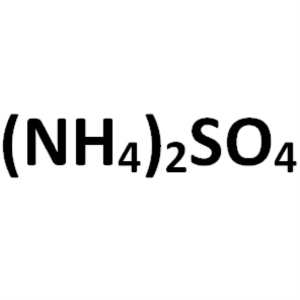
Ammonium Sulfate CAS 7783-20-2 Content 99.0~100.5%
-
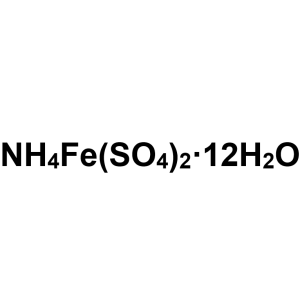
Ammonium Iron(III) Sulfate Dodecahydrate CAS 77...
-
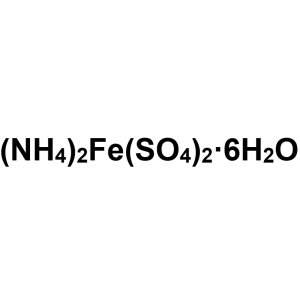
Ammonium Iron(II) Sulfate Hexahydrate CAS 7783-...
-
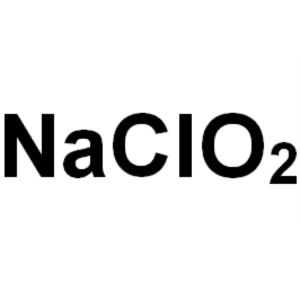
Sodium Chlorite CAS 7758-19-2 Assay >80.0% (HPLC)
-
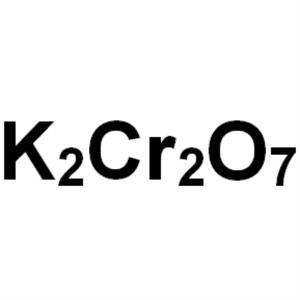
Potassium Dichromate CAS 7778-50-9 AR, Assay 99.8%
-
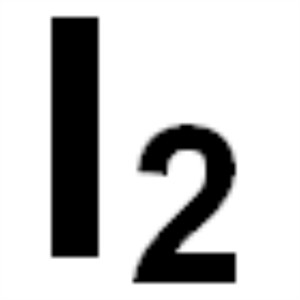
Iodine CAS 12190-71-5 (Chile) Content ≥99.8% Fa...
-
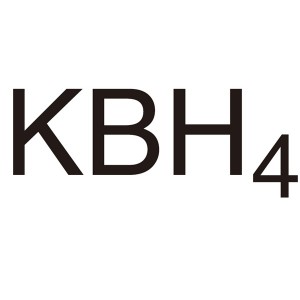
Potassium Borohydride CAS 13762-51-1 Assay (KBH...
-
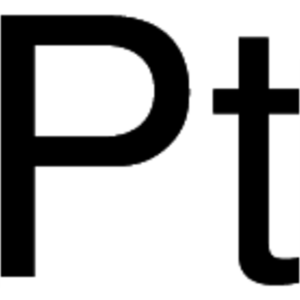
Platinum Black CAS 7440-06-4 Assay Pt ≥99.95% F...
-
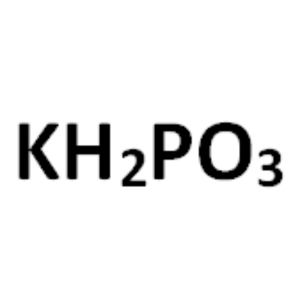
Monopotassium Phosphite CAS 13977-65-6 Purity >...
-
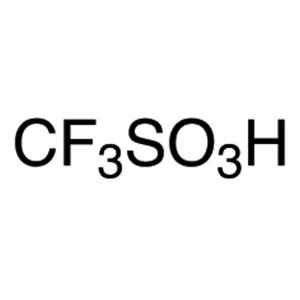
Trifluoromethanesulfonic Acid CAS 1493-13-6 Pur...
-
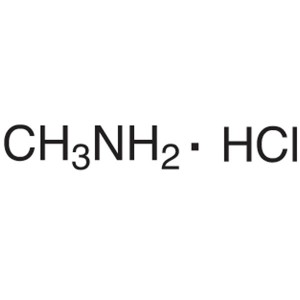
Methylamine Hydrochloride CAS 593-51-1 Purity >...
-
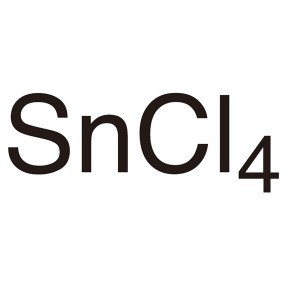
Tin(IV) Chloride Anhydrous CAS 7646-78-8 Purity...
-
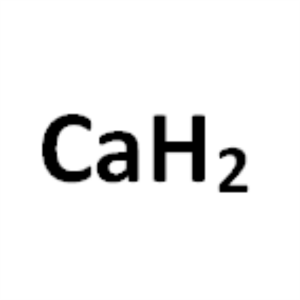
Calcium Hydride CAS 7789-78-8 Purity (Total Ca)...
-
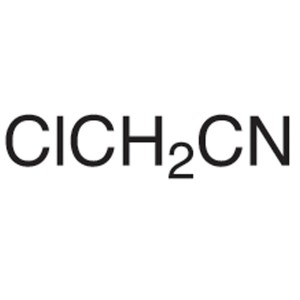
Chloroacetonitrile CAS 107-14-2 Purity >99.5% (GC)
-
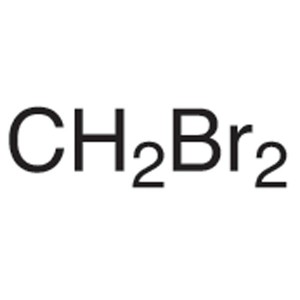
Dibromomethane CAS 74-95-3 Purity >99.5% (GC)
-
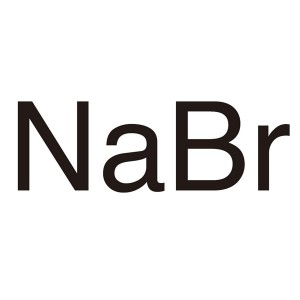
Sodium Bromide CAS 7647-15-6 Purity >99.0% (T) ...

